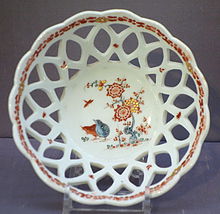
Back Ажур (узор) BE Ažur Czech À jour German Aĵuro EO Calado (ornamentación) Spanish مشبککار FA Ajour French אז'ור HE Seni kerawang ID Traforo (motivo decorativo) Italian



Openwork or open-work is a term in art history, architecture and related fields for any technique that produces decoration by creating holes, piercings, or gaps that go right through a solid material such as metal, wood, stone, pottery, cloth, leather, or ivory.[2] Such techniques have been very widely used in a great number of cultures.
The term is rather flexible, and used both for additive techniques that build up the design, as for example most large features in architecture, and those that take a plain material and make cuts or holes in it. Equally techniques such as casting using moulds create the whole design in a single stage, and are common in openwork. Though much openwork relies for its effect on the viewer seeing right through the object, some pieces place a different material behind the openwork as a background.
- ^ British Museum Ref:1994,0408.29
- ^ "Openwork." Grove Art Online, Oxford Art Online. Oxford University Press, accessed May 26, 2015, subscription required. Their article reads, in full: "Any form of decoration that is perforated". OED "Openwork", 1, where all examples cited from earlier than 1894 are hyphenated, though this is now less common than the single word.